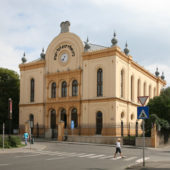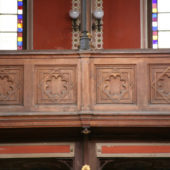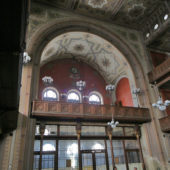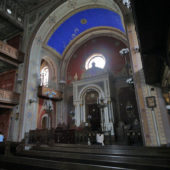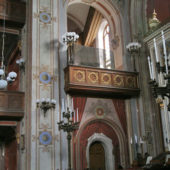Only remaining synagogues of Pecs’ pre-Holocaust four.
Built in Hungarian romantic style, the Pecs Synagogue reflects the exuberance of a prosperous and growing Jewish community that only a few years earlier had been banned from settling in Hungarian towns and cities such as Pecs.
Emancipated in the late 1840s, Jews swiftly migrated into Hungary’s towns and in Pecs they quickly established themselves, setting up a well-respected school by the middle of the 1850s along with two synagogues. By the mid 1860s, plans for a new, third synagogue (one of four eventually built in Pecs) were underway. Three highly regarded Hungarian architects had a hand in the synagogue’s design: Frederick Feszl, Charles Gerster and Leonard Lepot. The builder was Stephen Ivankovics.
Work began in 1865 and the synagogue was dedicated on July 22, 1869. Located near the center of Pecs, the synagogue features an attention grabbing peach colored exterior and a distinct tri-partite design with a clock mounted high on the front. Scrolled above the clock is a Hebrew inscription reading “The house of worship for all people,” and above that is perched a replica of the Mosaic tablets showing the 10 Commandments.
The impressive interior likewise has three distinct areas with a main nave and two aisles. The ceiling rises to a height of over 18 meters, creating a sense of spaciousness and on either side of the synagogue’s interior, galleries for the women rise two stories above the main hall. The galleries seated about 448 while the main floor seated 476 men.
To this day, the synagogue’s interior remains entirely original and the dark slavonian oak, from which the seating is made, dominates the character of the main level. Above the entrance, one can glimpse from the first and second pillars of either gallery, the rosette located behind the crown of the cupola. The rosette features the Tetragrammaton, or name of God, YHWH (Yahweh). Gold topped pillars frame the Ark, or Aron ha Kodesh, in the sanctuary which is covered by a dome. Again, a small reproduction of the tablets testifies to the contents of the Ark.Two doors are located in the sanctuary, one leading to the Rabbi’s room, the other to the Cantor’s room. Above the rabbi’s room is a choir area and opposite it, an organ. The organ, truly innovative for its time, especially in a synagogue, has two manuals, 24 registers and 1,534 pipes.
On a small table beneath the bimah, or pulpit, there is a Hebrew Bible and a “Book of Tears” recording the names of the members of Pecs’ congregation and other Jews in the area who lost their lives in the Holocaust. Plaques located on the interior walls of the synagogue also testify to the tragedy.
Nearly 90 percent of Pecs’ Jews were wiped out in the Holocaust. They lived in town through early 1944, until the Nazis occupied Hungary and swiftly began roundups and deportations. By early July of 1944, the ghetto was emptied and most of Pecs’ Jewish population was shipped off the Auschwitz, never to return again. When the Soviet Army liberated the town in December of 1944, a few of the survivors began to trickle back and shortly after the cessation of the conflict, several hundred had returned.
The synagogue remains in use although Pecs’ Jewish population has continued to dwindle. Throughout Hungary, just a few thousand Jews remain from what was once one of Europe’s most robust populations. The synagogue remains open for visitors to appreciate its beauty and history.
For more information see http://www.wmf.org/project/p%C3%A9cs-synagogue

